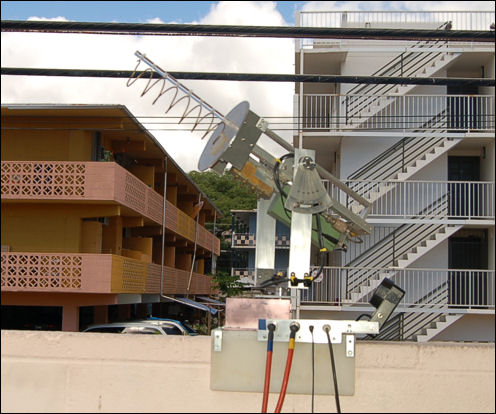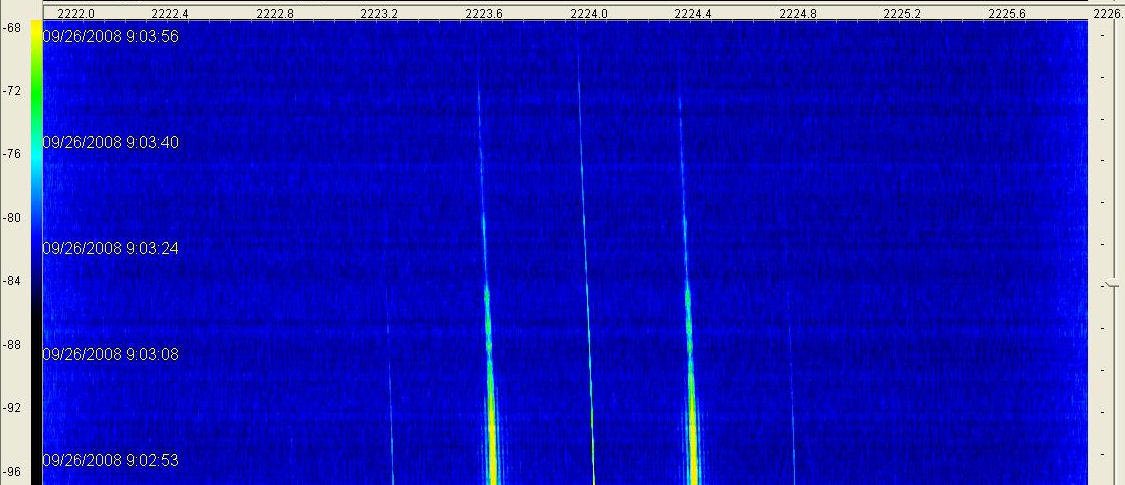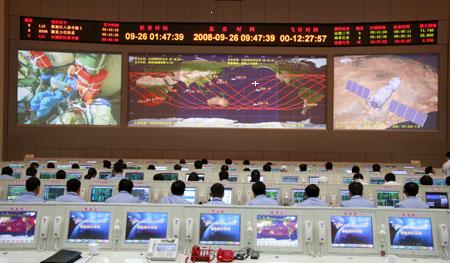Tracking Shenzhou 7 from
Honolulu
Richard S.
Flagg
25 September 2008
The Shenzhou 7 spacecraft was launched at 13:10:04.988 UT
from the Jiuquan Satellite Launch Center in the Gansu province.
26 September
2008
Here in Hawaii I had a good opportunity to search for signals
on a pass
starting at 0900 UT (11 PM local time). Using a 7-turn helix (se picture
below), an AR5000 and an SDR-14 I began searching S-band at 0900. The
antenna was fixed at an azimuth of 320 degrees and an elevation
angle of 45 degrees. The SDR-14 allowed me to view a 4 MHz
wide chunk of spectrum. The search plan was to start at
2200 MHz and step the frequency of the AR5000 by 1 MHz
every few seconds.

At 0902 UT I came across a strong signal on 2224 MHz. A
quick check of my frequency list revealed that this was probably something new.
The signal on 2224.0 MHz appeared as a main carrier and at
least two sidebands approximately +/- 384 kHz from the main carrier. The signal
peaked at the correct time for passage through my beam. Loss-Of-Signal
(LOS) was at about 0904 UT. The waterfall spectrogram from the SDR-14
is shown below.

I decided that on the next pass I would
search for a VHF signal using a small 250 MHz broadband Yagi. Here in
downtown Honolulu VHF conditions are terrible due to powerful local TV and FM
broadcast stations. There were dozens of spurious signals between 250 and 300
MHz, which fortunately dissapeared with the use of an FM band (88-108 MHz ) band
reject filter. I checked several frequencies beteen 2329:30 UT and
2345 UT but came up with nothing. Switching to S-band, I
picked up Shenzhou on 2224 MHz at 2345:25 UT- when the spacecraft was at az 82o
and el 21o Again the central carrier and the closest sidebands were
clearly visible. At 2346:35 the sidebands began to fade and at 2347:00 the
carrier abruptly disappeared (Az 65o, El 8o at LOS). It could have
been commanded off, but it is more likely that Shenzhou went behind one of the
tall buildings causing the signal to be blocked. I was interested to learn
if the signal was on continuously, or perhaps being commanded from a ship
located in our part of the ocean. This pass was inconclusive because of
the all the buildings. I did conclude that if it is commanded by a
tracking ship, then the ship must be very close.
27 september - "EVA day"
Following
the previous pass there was a marginal northbound pass to the west of me which I
monitored on S-band. The track was in and out between apartment buildings
but I was curious to see if the transmitter was on.
0117:06 AOS
(Azimuth=285o, elevation=6o ).
0119 Fade out
0119:54
fade back in
0121:06
fade out again and soon gone (elevation=
6o
)
So it was a worthwhile attempt I think - strengthening
my belief that this transmitter is on continuously (or the ship is in
my backyard). The spectrogram - for what it is worth. is shown
below.
Sven
Grahn sent me an image of the the map on the
wall of the control center in Beijing and tried to put a mark where Hawaii
is located. (It's the white plus sign).The map seems to show the ship several hundred miles to the south (close
to the equator). If that is where it really
is then it could not have been in contact with Shenzou 7 during that
last northwesterlbetweennding pass 0117-0121 UT. So I think the transmitter is probably on
continuously.

Another observation seen when looking at the picture from
the Beijing control center, is that the orbital plane
and spacecraft location along the orbit is such that the sun is directly
overhead when the spacecraft crosses the equator on ascending
orbits.
The EVA was
scheduled to start at 0830 UT and last about 20 minutes. I had a pass just before
and another one just after the EVA. My plan was to look
again for VHF signals and also to scan the rest of S-band, to
see if there were any other frequencies in use. At 0744:44
I had AOS of 2224 and immediately began stepping up in frequency looking
for other signals. Wasted a minute or so with a weak carrier on
2251 MHz which was apparently terrestrial. I then switched from S-band to VHF at
0747 UT and scanned suspect frequencies between 250 and 300 MHz until 0754
UT. No VHF signals received.
On the post-EVA pass I had
AOS of the 2224.0 MHz signal at 0919:38 UT. I immediately started scanning
the upper end of S-band but saw nothing. At 0924 I again switched to
VHF but saw nothing. By this time I had scanned all of S-band and
found the 2224 MHz signal but nothing else. The VHF search (conducted on
several passes) produced no results.
28 september - "Landing
day"
My last
reception of Shenzhou 7 took place at about 0001-0005:30 UT. This was a nice pass
with good signal at "closest approach" making it possible to determine the
center frequency of the transmitter accurately (see below). The frequency is 2224.065 MHz.
The mission duration was 68
hours 28minutes and the re-entry vehicle with the three-man crew touched down in
Inner Mongolia at 0937:45 UT.

 Back to
Space Tracking Notes
Back to
Space Tracking Notes




